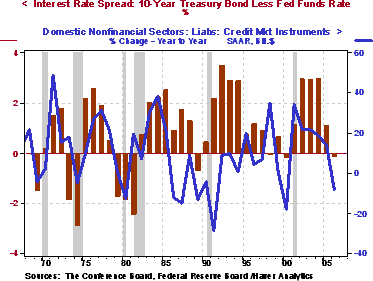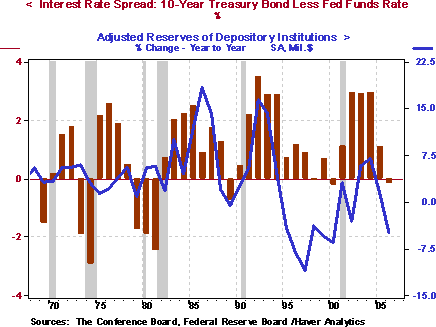The Inverted US Yield Curve - Is It Really Different This Time ?
Interest-Rates / Inverted Yield Curve Mar 16, 2007 - 12:32 PM GMTBy: Paul_L_Kasriel
One of the components of the index of Leading Economic Indicators is the spread between the 10-year nominal Treasury yield and the federal funds rate (hereafter referred to as “the spread”). When the spread is widening, it is thought to be a harbinger of faster future real economic growth; when the spread is narrowing, it is thought to be a harbinger of slower future real economic growth. When the spread becomes negative, or the yield curve inverts, a necessary condition of a recession occurs. That is, every recession starting with the one in 1970 has been preceded by a negative yield spread (See Chart 1, in which the shaded vertical areas represent recessions).
However, there has been one occasion since the recession of 1970 when the yield spread turned negative and a recession did not occur. That was in the summer of 1998 at the time of the Long-Term Capital Markets arbitrage fund meltdown. The pace of economic activity slowed at this time and the Federal Reserve quickly dropped the fed funds rate by 75 basis points, perhaps forestalling a recession.
Chart 1

Currently the spread is about 70 basis points into negative territory. It peaked in this cycle at 372 basis points on a monthly average basis in May 2004, the month before the Fed began lifting the federal funds rate. The spread first became negative in this cycle in July 2006, the month after the Fed ceased raising the federal funds rate. Most Federal Reserve officials and many mainstream business economists do not believe that the behavior of the spread in this cycle is sending the same message that it has in past cycles. That is, according to conventional wisdom, the current negative reading of the spread is not signaling a recession on the horizon. In contrast, I do believe that the negative spread is sending a strong signal of weak economic growth ahead.
Although I have not been bold enough to yet forecast an outright recession either later this year or early in 2008, my Q4/Q4 2007 real GDP growth forecast of 2.3% is below the latest Blue Chip Survey consensus of 2.75%. Moreover, my forecast would be for even weaker real economic growth if it were not for the 75 basis points of federal funds rate cuts I see beginning in August of this year. The Blue Chip Survey consensus forecast has a steady 3-month Treasury bill interest rate through the first three quarters of 2007 and then a 10 basis point decline in the fourth quarter. Thus, the Blue Chip Survey consensus forecast implicitly sees a federal funds rate cut coming later than I do and of smaller magnitude.
What is the theory behind the signaling characteristics of the spread? The behavior of the 10-year Treasury yield is a proxy for the supply-demand conditions in the credit market. When there is excess demand for credit, the 10-year yield tends to rise. Typically, the demanders of credit intend to use their borrowed funds to purchase a good or a service. Hence, all else the same, when the 10-year Treasury yield is rising, it reflects the increased demand for goods and services. When there is a decline in the relative demand for credit, the 10-year yield tends to fall. The Federal Reserve targets and controls the short-term price of credit – the federal funds rate.
If the spread is widening, that is, the yield on the 10-year Treasury is rising relative to the level of the federal funds rate, this is a sign that an excess demand for credit is developing and the Federal Reserve is accommodating some of that increased demand by creating credit figuratively “out of thin air.” The Federal Reserve has to create this credit – increase its provision of reserves to the banking system – in order to keep the federal funds rate from rising above its target level. The Federal Reserve's creation of credit is akin to a counterfeiter's creation of money in that someone's spending can increase without anyone else's spending being curbed. In contrast, if I were to lend you some funds, I would have to cut back on my spending (increase my saving) so that you could increase your spending.
I would be transferring my purchasing power to you rather than creating purchasing power. Alternatively, if the spread is narrowing, this suggests that the relative demand for credit is moderating and the Federal Reserve is extinguishing some of its “counterfeit” credit – i.e., it is draining reserves from the banking system. (See Paul L. Kasriel, “Falling Bond Yields Are A Sign Of Easier Monetary Conditions?” Positive Economic Commentary/The Econtrarian , The Northern Trust Company, July 8, 2005 and Paul L. Kasriel, “Greenspan's Uncertainty Principle: Premise Accepted, Conclusion Rejected,” Positive Economic Commentary , The Northern Trust Company, October 17, 2003 for a fuller explanation of these points.)
Let's see how this theory comports with the data. Chart 2 shows the relationship between annual real GDP growth and the annual average of the spread. The highest correlation between these two series (0.66 out of a possible 1.00) occurs when the spread leads by one year. Not bad. In 2006, the spread averaged a negative 17 basis points. This would suggest a significant slowing in real GDP growth in 2007 on an annual average basis. In 2006, the annual average real GDP was 3.3% above that of 2005. My forecast for annual average real GDP growth in 2007 is 2.2%. The latest Blue Chip Survey consensus estimate is 2.5%. In either case, a significant slowdown in real GDP growth is expected.
Chart 2

As mentioned above, a widening in the spread suggests strong demand for credit and a narrowing in the spread reflects weaker demand. How does the behavior of the spread fit these facts? Chart 3 shows the relationship between the spread and the year-over-year percent change in domestic nonfinancial entity credit market borrowing. The relationship is far from perfect, but generally as the spread is widening, the rate of growth in borrowing is rising and vice versa . Notice that in 2006, there was a sharp slowing in the growth of borrowing. This was due largely to the slowdown in mortgage borrowing as a result of the recession in the housing sector. So, the decline in the 10-year Treasury yield in 2006 coincided with a significant slowing in the demand for credit.
Chart 3

A widening in the spread, according to my theory, should be associated with faster growth in Federal Reserve-created bank reserves and vice versa . Chart 4 shows the behavior of the annual average spread vs. the growth in bank reserves. Again, although far from perfect, there is a general tendency for the growth in bank reserves to increase when the spread widens and vice versa . Notice that annual average bank reserve growth contracted by 4.8% in 2006 as the spread slipped into negative territory.
Chart 4

In sum, the behavior of credit demand and bank reserves in 2006 is entirely consistent with the theory of the spread I have outlined. And the recent weakening in real GDP growth – 2.3% on average in the past three quarters – and the consensus forecast for continued near-term weak growth also is consistent with the theory of the spread. Investors ignore the signal being sent by the currently inverted yield curve at their own peril.
*Paul Kasriel is the recipient of the 2006 Lawrence R. Klein Award for Blue Chip Forecasting Accuracy
By Paul Kasriel
The Northern Trust Company
Economic Research Department - Daily Global Commentary
Paul joined the economic research unit of The Northern Trust Company in 1986 as Vice President and Economist, being named Senior Vice President and Director of Economic Research in 2000. His economic and interest rate forecasts are used both internally and by clients. The accuracy of the Economic Research Department's forecasts has consistently been highly-ranked in the Blue Chip survey of about 50 forecasters over the years. To that point, Paul received the prestigious 2006 Lawrence R. Klein Award for having the most accurate economic forecast among the Blue Chip survey participants for the years 2002 through 2005.
The opinions expressed herein are those of the author and do not necessarily represent the views of The Northern Trust Company. The Northern Trust Company does not warrant the accuracy or completeness of information contained herein, such information is subject to change and is not intended to influence your investment decisions.
© 2005-2022 http://www.MarketOracle.co.uk - The Market Oracle is a FREE Daily Financial Markets Analysis & Forecasting online publication.



